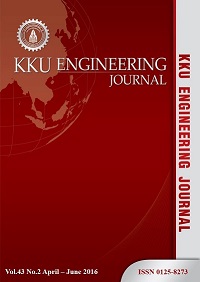Hydrological drought frequency analysis of the Yom River, Thailand
Main Article Content
Abstract
The Yom River is subjected to flooding and drought for six months each year. Several studies suggested storing water during the rainy season for use in the dry season. None of them, however, quantified the precise amounts of storage needed along the river with acceptable risks. In an attempt to quantify the required storage, we performed frequency analyses to learn the severity of streamflow droughts along the river. A deficit volume, defined as when the amount of flow is less than a selected threshold level, was used to characterize a drought event. The Weibull distribution model was chosen for analysis after comparison of log normal and Pareto models with an empirical distribution. Results showed a more severe drought condition exists towards the downstream section of the river where paddy fields are larger. A large deep groundwater irrigation project located near the mid-section of the river mitigates drought along this section. Drought is more severe further downstream from the project. One reason for this is that the baseflow is cut off by groundwater abstraction. This method presented can help to quantify the severity of hydrological drought along any river so that drought management measures can be undertaken.
Article Details
How to Cite
Sawatpru, K., & Konyai, S. (2016). Hydrological drought frequency analysis of the Yom River, Thailand. Engineering and Applied Science Research, 43(2), 100–107. retrieved from https://ph01.tci-thaijo.org/index.php/easr/article/view/43173
Issue
Section
ORIGINAL RESEARCH
This work is licensed under a Creative Commons Attribution-NonCommercial-NoDerivatives 4.0 International License.



